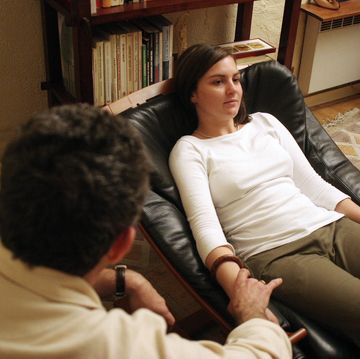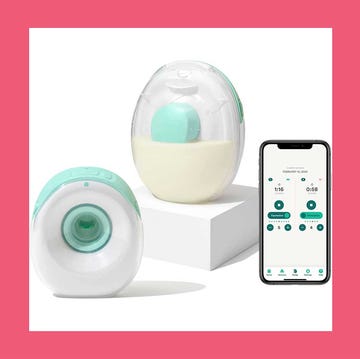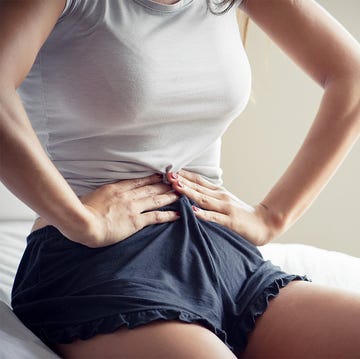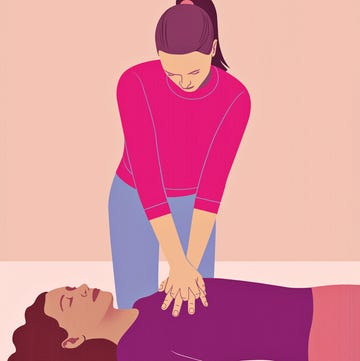You always wash your hands after using the bathroom and before cooking dinner. You'd never share a toothbrush with a friend (or even your husband). But there are other germ hot spots you probably haven't thought about.
One of the main ways you get sick is by touching a dirty surface, then touching your face—germs get into your body through your eyes, nose and mouth. That's why washing your hands is one of your best defenses. The other? Knowing which areas rank high in terms of germs. With all of the colds and flu circulating this time of year, it pays to be extra-careful.
1. In The Laundry
Before loading the washer, you sort your clothes into whites and colors. Next time, consider also sorting by use: That means putting food-related items like dishcloths and kitchen towels into one load and underwear and bathroom towels into another. Why? "Most people wash all of their laundry in cold or lukewarm water, which only removes and kills about 80% of bacteria," says Charles Gerba, PhD, a professor of microbiology at the University of Arizona in Tucson. Inside the machine, dirty wash water can spread germs through the entire load, even leaving them behind on the walls of the machine.
Keep It Clean: Wash high-risk items on hot and thoroughly dry them in the dryer. Once a month, decontaminate the washer by running a load (or an empty cycle) with a capful of bleach, suggests Dr. Gerba. Photo: Shutterstock
2. In Your Kitchen
You just made chicken cutlets for dinner, and you grab a sponge to wipe down the remnants of raw chicken, eggs and other ingredients left behind on your countertops. Stop right there! The mess you're wiping up could include germs like salmonella (which can survive on hard surfaces for days, even months) that can cause very unpleasant stomach symptoms and fever.
Porous, wet and full of nooks for bits of food to hide in, the sponge is "a super-condo for bacteria," says Elizabeth Scott, PhD, founder and codirector of the Center for Hygiene and Health in Home and Community at Simmons College in Boston. It's even germier than the inside of a toilet bowl, says Dr. Gerba.
So if you're using the same sponge to wash dishes and clean your counters, you could be just spreading more germs around.
Keep It Clean: Use separate sponges for dishes and counters, and put your sponges in the dishwasher whenever you run it. Microwaving them on high for one minute also works. For countertops, consider skipping the sponge in favor of disinfectant wipes or paper towels, recommends Paul Dawson, PhD, a professor of food science at Clemson University.
Fact: The "5-second Rule" is a Myth
Experiments testing the theory that food dropped on the floor is safe to eat if you pick it up within 5 seconds found that 99% of salmonella bacteria made its way onto fallen food almost immediately. "A flat, moist banana slice will pick up more microbes than a jagged, dry tortilla chip, but where the food contacts the floor, there's just as much transfer in 5 seconds as in 60," says study coauthor Paul Dawson, PhD. "And it only takes a small amount of some types of bacteria to make you sick." Photo: Shutterstock
3. At The Grocery Store
Those plastic covers made for the seat area of the shopping cart were created for good reason: "We find more E. coli on shopping carts than on toilet seats," Dr. Gerba says. "In addition to germs from food, children's dirty bottoms are going in the seat—and the carts are hardly ever cleaned."
The checkout screens where you swipe your credit or ATM card aren't great, either. In some grocery stores, up to 80% have E. coli on them—likely picked up from people handling leaky meat packages and unwashed produce, then touching the screen. Another germy spot: Your reusable grocery bag. Yes, you're being environmentally conscious, but bacteria from meat and produce from your last trip are probably still in there. "Only 3% of people surveyed say they have ever washed their totes, and half use them for carrying other things, like dirty clothes," Dr. Gerba says. "That's like hauling your groceries home in your dirty underwear."
Keep It Clean: Wipe grocery cart handles and seats with a disinfecting wipe (look for a dispenser in your supermarket) and line the seat area with a plastic bag before wheeling it around the store. After leaving the store, be sure to wash your hands or apply sanitizing hand gel. In addition to washing reusable bags regularly, set one aside for raw meats, or wrap meat packages in a plastic bag before putting them in your tote.
What about money and pens? Yes, they've been handled by hundreds of people, but your risk of contamination from money is low because germs stick to the porous fibers of paper bills and don't transfer easily to your hands, Dr. Gerba says. Nickel and copper have antimicrobial properties that make coins relatively low-risk. Public pens have also come up surprisingly clean in Dr. Gerba's research. "In some stores, pens are disinfected at the end of the day,"
he says. Photo: iStock
4. In The Bathroom
Washing your hands is a no-brainer. Suds up for 15 to 20 seconds—about the time it takes to sing "Happy Birthday," says Carlene Muto, MD, medical director for infection control at the University of Pittsburgh Medical Center. But the faucet itself may not be so sanitary: Constant contact with hands and moisture means the taps are teeming with bacteria. One study found that wet places like faucet handles were among the most likely places in the home to harbor superbugs like MRSA, a painful and potentially life-threatening skin infection.
Bathroom towels are another always-damp place where bacteria like E. coli (which cause stomach pain and vomiting) thrive, since they collect germs from hands and toilet droplets.
Keep It Clean: Close the toilet lid before flushing; otherwise, every time you flush, some of the dirty water sprays into the air. Spritz faucets and taps daily with disinfectant, and in public places, turn off the water with a paper towel. Change hand towels as often as possible and consider using paper towels for guests. Change bath towels every three days.
What about your toothbrush? "It's loaded with bacteria—but it's your own, so unless you've been sharing, there's little evidence that germs on it will make you sick," says Abigail Salyers, PhD, professor of molecular and cellular biology at the University of Illinois, Urbana-Champaign. Just store the toothbrush so it dries between uses, and toss it if you've had strep or a stomach bug, since using it when you're better could make you sick again.
Tip: When using a public bathroom, consider choosing a stall on either end of a row; they're used less often than the middle stalls.
5. The Bottom of Your Bag, Suitcase or Backpack
You come home after your bag has been in a shopping cart, on the floor and who knows where else and plop it on the kitchen counter. Get ready for the gross factor: Research shows that bacteria like E. coli cling to the bottom of 18% of bags. Keep bags off the floor and whatever you do, don't set a bag on any surface where food is made or eaten. Photo: iStock
6. The TV Remote
Everyone touches it, but very few people ever clean it. Swab it with a disinfecting wipe or a cloth using a solution of 1 part bleach to 9 parts water.
Richard Laliberte is an award-winning health and science writer based in the Allentown, Pennsylvania, area.

Richard Laliberte is an award-winning veteran health journalist and former senior writer at Men's Health who writes for some of the nation's best-known magazines, blogs for WeightWatchers.com, and has authored several books.













